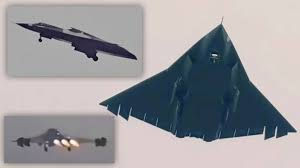OSINT/PAI Revelations: The Chinese J-50 Fighter and the Challenge to the Era of Air Warfare
- Nicola Iuvinale
- 3 ago
- Tempo di lettura: 4 min
According to new OSINT/PAI (Open-Source Intelligence / Publicly Available Information) revelations, the Chinese sixth-generation fighter, the J-50, is presented as an aircraft that redefines the concept of air warfare, operating as an integrated "combat system." Its features include advanced stealth technology across the entire electromagnetic spectrum and hypersonic capabilities that would allow it to operate in suborbital space. The aircraft is equipped with a weapon system that includes hypersonic missiles, lasers, and railguns, and it functions as a flying command center for swarms of drones. The development of the J-50 poses a direct threat to US air superiority in the Pacific, especially to American military bases on the Second Island Chain. Its existence forces the United States to revise its defense strategies in the face of an adversary that is shaping the future of air combat.
by Gabriele and Nicola Iuvinale

The Dawn of a New Conflict: The Chinese J-50 Fighter and the Era of Hypersonic Warfare
According to an analysis from Beijing, the recent successful maiden flight of the Chinese three-engine sixth-generation fighter, the J-50, marks a turning point in global air warfare. This development is not a simple evolution of fifth-generation fighters like the US F-22 but a radical leap toward a "combat system" that redefines the rules of the game. If the descriptions from Chinese sources prove even partially accurate, the United States and its allies would face an unprecedented technological and strategic challenge.
Next-Generation Stealth and the "Suborbital Ghost"

The J-50, with its bold design that merges a "lambda wing" with a "flying wing," abandons traditional vertical and horizontal surfaces, which are notorious weak points for radar reflection. The aircraft, according to sources, uses advanced materials like a gallium nitride smart film that actively neutralizes radar waves, reducing its Radar Cross-Section (RCS) to just 0.0001 square meters. This value is two orders of magnitude smaller than the F-22's, making the J-50 nearly invisible to current radar systems.
But the J-50's stealth threat isn't limited to the radar band. The same sources indicate a "full-band stealth" capability, with air intakes and nozzles coated with advanced materials and a reduction in its infrared signature that would blind enemy thermal sensors. In practice, this aircraft would not only be nearly impossible to track by radar but also extremely difficult to hit with infrared-guided missiles.
The true innovation, however, is its propulsion system. With two WS-15 turbofans for cruising and a third ramjet engine for high speeds, the J-50 can reach Mach 3.2. At an altitude of 50,000 meters, a level described as "suborbital space," the J-50 would far surpass the F-22's supersonic cruising performance. This ability to operate at extreme speeds and altitudes makes it a true "suborbital ghost," difficult to intercept and incredibly lethal.
The Doctrine of "Strategic Overmatch" and the Missile Threat
The J-50 is not just an aerial platform; it's a "warfare system." Its ability to integrate into an inter-domain combat network is the real linchpin of China's military doctrine. With a pilot who, through an AR helmet, can control a swarm of 500 drones, the J-50 becomes a flying command center, orchestrating complex and coordinated attacks.
Its firepower is equally unsettling. According to the analyses, the internal bomb bay can house two 4-ton hypersonic missiles or eight PL-17 ultra-long-range air-to-air missiles. With a range of 400 kilometers and a quantum radar locking system, the PL-17 could shoot down enemy aircraft long before the J-50 is ever detected. The presence of a 200-kilowatt laser system and a railgun demonstrates Beijing's willingness to integrate both traditional and next-generation energy and kinetic weapons, creating a "spear and shield" in a single platform.
This technological evolution, if confirmed, has a clear strategic purpose: to neutralize the Second Island Chain in the Pacific, where crucial US military bases like Guam are located. Judging by its estimated range of 6,000 kilometers (with more optimistic estimates speaking of tens of thousands of kilometers), the J-50 could directly threaten US forces in the region. Unlike costly strategic bombers, a fleet of J-50s could conduct repeated, large-scale attacks, extending the reach of China's tactical air fleet far beyond its current boundaries.
Final Considerations
The emergence of platforms like the J-50, along with the rumored J-36 fighter, reveals a Chinese strategic mindset that aims for rapid control of the Western Pacific. The emphasis on the "combat system" and hypersonic intelligent warfare suggests that China is preparing for challenges that go beyond simple aerial confrontation.
The United States, while continuing to refine its fifth-generation fighters, faces an adversary that seems to have already laid the groundwork for the next era of warfare. If the reported specifications prove even partially true, US air superiority in the Pacific would no longer be a given. On the contrary, the US would have to contend with a threat capable of operating undisturbed at unimaginable distances and speeds, jeopardizing not only military bases but the entire defense strategy in the region. The arms race has entered a new, and perhaps more dangerous, phase.



Commenti